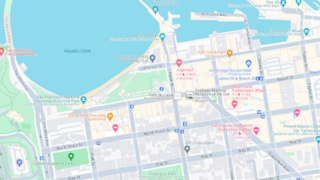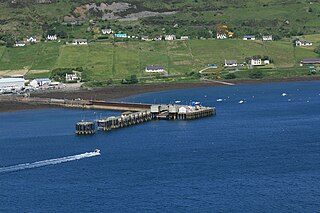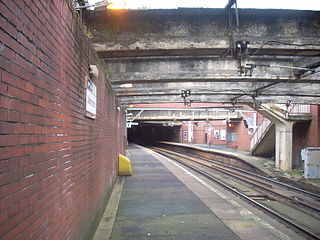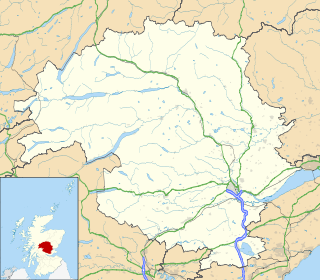The Ceilidh Trail is a scenic roadway in the Canadian province of Nova Scotia.

Portree is the largest town on, and capital of, the Isle of Skye in the Inner Hebrides of Scotland. It is the location for the only secondary school on the island, Portree High School. Public transport services are limited to buses.

Trotternish or Tròndairnis is the northernmost peninsula of the Isle of Skye, in Scotland. Its most northerly point, Rubha Hùinis, is the most northerly point of Skye.

Google Maps is a web mapping platform and consumer application offered by Google. It offers satellite imagery, aerial photography, street maps, 360° interactive panoramic views of streets, real-time traffic conditions, and route planning for traveling by foot, car, air and public transportation. As of 2020, Google Maps was being used by over 1 billion people every month around the world.

The River Kelvin is a tributary of the River Clyde in northern and northeastern Glasgow, Scotland. It rises on the moor south east of the village of Banton, east of Kilsyth. At almost 22 miles (35 km) long, it initially flows south to Dullatur Bog where it falls into a man made trench and takes a ninety degree turn flowing west through Strathkelvin and along the northern boundary of the bog parallel with the Forth and Clyde Canal.

Uig is a village at the head of Uig Bay on the west coast of the Trotternish peninsula on the Isle of Skye, Scotland. In 2011 it had a population of 423.

Aberuthven is a small village in Perth and Kinross, Scotland. It lies approximately 2+1⁄2 miles northeast of Auchterarder and 10 miles southwest of Perth at an elevation of 128 feet. It lies on the A9 and A824 roads which has been bypassed along with Auchterarder since 1983. The village is centred on the village hall and has changed over the years almost doubling in size and population.
Achnaha is a remote village in Ardnamurchan, Lochaber, in the Scottish council area of Highland.

Struan is a small village on the west coast of the island of Skye, on the shores of Loch Beag, itself an inlet of Loch Bracadale. "Struan" is the anglicized form of the Scottish Gaelic word sruthan, meaning "small stream", or the flow at the point where a spring appears.

St Fillans is a village in the central highlands of Scotland, in the council area of Perth and Kinross. The village lies at the eastern end of Loch Earn, 5 miles (8 km) west of Comrie on the A85 road, at the point where the River Earn leaves the loch. St Fillans was a small clachan in the 18th century, known as Port of Lochearn, or Meikleport. In 1817 it was renamed St Fillans by Lord Gwydyr, the husband of Clementina Drummond, heiress to the Drummond Estate.

Rutherglen railway station is in the town centre of Rutherglen, South Lanarkshire, Scotland, and lies on the Argyle Line. The station is served by a single island platform, connected to the street by a footbridge.

Dalmarnock railway station, serving the Dalmarnock area of Glasgow, Scotland, lies on the Argyle Line, two and a quarter miles (3.6 km) southeast of Glasgow Central. The northern ends of the side platforms are within a tunnel. Revamped for the 2014 Commonwealth Games, the station is a 15-minute walk from the Commonwealth Arena and Sir Chris Hoy Velodrome, and Celtic football club's Celtic Park stadium at Parkhead.

Lochrin is a small area in Edinburgh, the capital of Scotland. It is in the south-west corner of the city centre, to the west of Tollcross, and south of Fountainbridge. Lochrin contains a wide mixture of retail shops, leisure facilities, other businesses and tenement housing. Major new office and residential developments have replaced some of the older buildings.

Google Street View is a technology featured in Google Maps and Google Earth that provides interactive panoramas from positions along many streets in the world. It was launched in 2007 in several cities in the United States, and has since expanded to include cities and rural areas worldwide. Streets with Street View imagery available are shown as blue lines on Google Maps.

Kilspindie is a village in Perth and Kinross, Scotland. It is situated on the Kilspindie burn, approximately 2+3⁄4 miles northwest of Errol, 12 miles west of Dundee centre and 6+1⁄2 miles east of Perth. The village has an area of 6,500 acres of which 3,500 acres are arable land and 200 acres are woodland, the local geology is mostly whinstone, amygdule and trap. Records show there was a chapel in the village since at least 1214 though the current church, the Kilspindie and Rait Parish Church, was built in 1670 and refurbished in 1938. The village previously housed the Kilspindie Castle which was demolished before 1670.

Rait is a small village in Perth and Kinross, Scotland. It lies 2+1⁄2 miles northwest of Errol, in the Gowrie area west of Dundee, on a minor road crossing the Sidlaw Hills through the Glen of Rait. The village is mainly residential with stone cottages, some modern developments and also features some single storey thatched cottages dating back to the 1700s or early 1800s which form a fermtoun. The former parish church, now ruined, was built in the Middle Ages, and abandoned in the 17th century when the parish of Rait was merged with Kilspindie. The remains of a prehistoric promontory fort lie to the east of the village. The 16th-century Fingask Castle is located to the north of the village, on the south-facing slopes of the Sidlaw Hills.

Rhynd is a hamlet in Perth and Kinross, Scotland. It is located 3+1⁄4 miles southeast of Perth, on the south side of the River Tay.
The Switchback was a railway line in the East End of Glasgow, Scotland, constructed by the Caledonian Railway (CR). Connecting the lines at Rutherglen on the south side of the city with Robroyston on the north side, this route also served a number of industrial sidings and rail yards.

The County of Peebles was the world's first four-masted, iron-hulled full-rigged ship. It was built during 1875, by Barclay Curle Shipbuilders in Glasgow, Scotland, for the shipping company R & J Craig of Glasgow. Measuring 81.2 metres long, with a beam of 11.8 metres, a draught of 7.1 metres and a cargo capacity of 1,614 net register tons (NRT), it was a state-of-the-art windjammer when it began its use, for the jute trade between the ports of Dundee and Cardiff in Great Britain and Bombay and Calcutta / Hooghly River in East India. Its rig was 'Scottish style', with royal sails above double top-sails and single topgallants.
Margadale is an area in the northeast of the Island of Islay, in the Inner Hebrides of Scotland, near Bunnahabhain. Margadale Hill and Margadale River are located in this area. The area lends its name to the barony of Margadale of Islay in the County of Argyll, a title in the Peerage of the United Kingdom. The area, as well as most of Islay, is owned by Alastair Morrison.
















